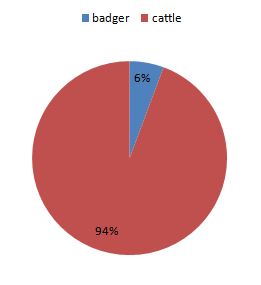
While cattle are the main animals to be infected with bTB, various scientific reports such as by Krebs (1997) suggest that Eurasian badgers (Meles meles) act as a wildlife reservoir and can transmit bTB to cattle.
Badger infection rate is estimated to be ~4-6% (RSPCA), and badger to cattle transmission may account for 5.7% of the total bTB infections in Great Britain cattle. The rest of the cattle infections are thought to derive from cattle-to-cattle transmission (McDonald, 2014).

In order for badger to cattle transmission, certain criteria must be met:
- susceptible cattle
- badgers must be excreting bacteria such that cattle can encounter it
- cattle must encounter min. infectious dose of bacteria (5 bacilli through aerosols)
While transmission is thought to occur through aerosols, feces, or urine, the exact mechanism of transmission from badger to cattle is unknown and controversial (Lodge and Matus, 2014).
Potential transmission mechanisms include:
- Contaminated pasture (urine/feces from badger encountered by cattle)
- Unlikely since cattle avoid contaminated feed (Benham and Broom, 1991)
- Badger visits to cattle housing while foraging for food
- Enhanced transmission with low ventilation housing
- Badgers would tend to visit cattle feed stores -> possible contamination
- Direct contact with cattle
- When bTB in late, terminal stage, badger behaviour changes (more active and less fearful of cattle)
- Cattle very curious
- When combined… increased contact between badgers and cattle

And buy cow pleas
Thank good for me please I need feed and hay I do it myself BJ Klose uncle